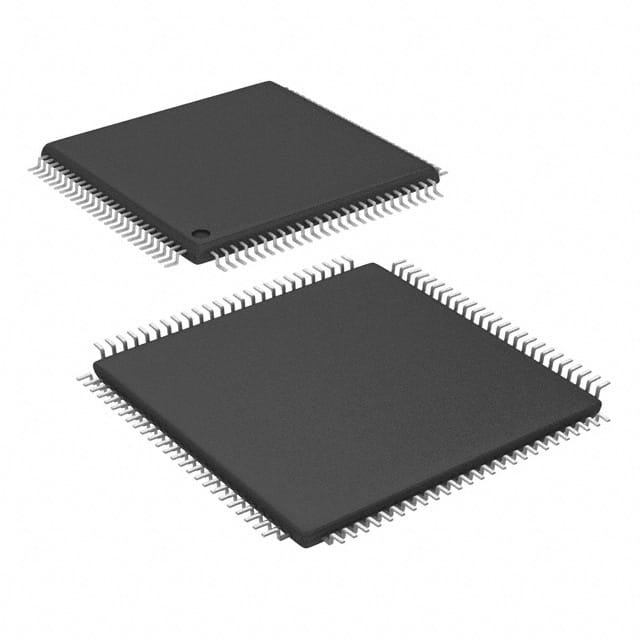DSPIC33EP256GM710T-I/PF
Overview
- Category: Microcontroller
- Use: Embedded systems, control applications
- Characteristics: High performance, low power consumption, advanced peripherals
- Package: TQFP
- Essence: Digital Signal Controller (DSC)
- Packaging/Quantity: Tray, 160 pieces per tray
Specifications
- Architecture: dsPIC33E
- Flash Program Memory: 256 KB
- RAM: 16 KB
- Operating Voltage Range: 2.5V to 3.6V
- Maximum CPU Speed: 70 MIPS
- Number of I/O Pins: 100
- Analog-to-Digital Converter (ADC): 10-bit, 16 channels
- Digital-to-Analog Converter (DAC): 12-bit, 4 channels
- Communication Interfaces: UART, SPI, I2C, CAN
- Timers: 16-bit and 32-bit timers
- PWM Channels: Up to 9
- Operating Temperature Range: -40°C to +85°C
Pin Configuration
The DSPIC33EP256GM710T-I/PF microcontroller has a total of 100 pins. The pin configuration is as follows:
- VDD
- VSS
- OSC1/CLKI
- OSC2/CLKO
- AN0/RB0
- AN1/RB1
- AN2/RB2
- AN3/RB3
- AN4/RB4
- AN5/RB5
- AN6/RB6
- AN7/RB7
- AN8/RB8
- AN9/RB9
- AN10/RB10
- AN11/RB11
- AN12/RB12
- AN13/RB13
- AN14/RB14
- AN15/RB15
- VCAP
- AVDD
- AVSS
- REFO/RF0
- RF1
- RF2
- RF3
- RF4
- RF5
- RF6
- RF7
- RF8
- RF9
- RF10
- RF11
- RF12
- RF13
- RF14
- RF15
- RG0
- RG1
- RG2
- RG3
- RG4
- RG5
- RG6
- RG7
- RG8
- RG9
- RG10
- RG11
- RG12
- RG13
- RG14
- RG15
- RH0
- RH1
- RH2
- RH3
- RH4
- RH5
- RH6
- RH7
- RH8
- RH9
- RH10
- RH11
- RH12
- RH13
- RH14
- RH15
- RJ0
- RJ1
- RJ2
- RJ3
- RJ4
- RJ5
- RJ6
- RJ7
- RJ8
- RJ9
- RJ10
- RJ11
- RJ12
- RJ13
- RJ14
- RJ15
- RP0
- RP1
- RP2
- RP3
- RP4
- RP5
- RP6
- RP7
- RP8
- RP9
- RP10
- RP11
- RP12
Functional Features
- High-performance digital signal processing capabilities
- Advanced peripherals for control applications
- Low power consumption for energy-efficient designs
- Wide operating voltage range for flexibility
- Extensive communication interfaces for connectivity
- Multiple timers and PWM channels for precise timing and control
Advantages and Disadvantages
Advantages: - High performance for demanding applications - Low power consumption for energy efficiency - Advanced peripherals for versatile functionality - Wide operating voltage range for flexibility - Extensive communication interfaces for connectivity
Disadvantages: - Limited availability of alternative models - Higher cost compared to some other microcontrollers - Steeper learning curve for beginners due to advanced features
Working Principles
The DSPIC33EP256GM710T-I/PF is based on the dsPIC33E architecture, which combines the features of a microcontroller and a digital signal processor (DSP). It utilizes a Harvard architecture with separate program and data
10个与DSPIC33EP256GM710T-I/PF在技术解决方案中的应用相关的常见问题及解答
What is the maximum operating frequency of DSPIC33EP256GM710T-I/PF?
- The maximum operating frequency of DSPIC33EP256GM710T-I/PF is 70 MHz.
What are the key features of DSPIC33EP256GM710T-I/PF?
- DSPIC33EP256GM710T-I/PF features a high-performance CPU, high-speed ADC, multiple communication interfaces, and extensive peripheral integration.
Can DSPIC33EP256GM710T-I/PF be used in motor control applications?
- Yes, DSPIC33EP256GM710T-I/PF is well-suited for motor control applications due to its advanced PWM modules and motor control peripherals.
What development tools are available for programming DSPIC33EP256GM710T-I/PF?
- Development tools such as MPLAB X IDE and MPLAB XC compilers can be used for programming DSPIC33EP256GM710T-I/PF.
Is DSPIC33EP256GM710T-I/PF suitable for digital power supply applications?
- Yes, DSPIC33EP256GM710T-I/PF is suitable for digital power supply applications with its integrated high-resolution PWM modules and analog-to-digital converters.
Does DSPIC33EP256GM710T-I/PF support communication protocols like SPI and I2C?
- Yes, DSPIC33EP256GM710T-I/PF supports communication protocols such as SPI, I2C, UART, and CAN.
What are the available memory options in DSPIC33EP256GM710T-I/PF?
- DSPIC33EP256GM710T-I/PF offers up to 256 KB of flash memory and 28 KB of RAM.
Can DSPIC33EP256GM710T-I/PF be used in industrial automation applications?
- Yes, DSPIC33EP256GM710T-I/PF is suitable for industrial automation applications due to its robust set of peripherals and communication interfaces.
What are the temperature range specifications for DSPIC33EP256GM710T-I/PF?
- DSPIC33EP256GM710T-I/PF has a temperature range of -40°C to 125°C, making it suitable for harsh environments.
Are there any application notes or reference designs available for DSPIC33EP256GM710T-I/PF?
- Yes, Microchip provides application notes and reference designs to assist in the implementation of DSPIC33EP256GM710T-I/PF in various technical solutions.


